Accepted Scientific Name: Pritchardia pacifica Seem. & H.Wendl.
Bonplandia 10: 197 (1862)
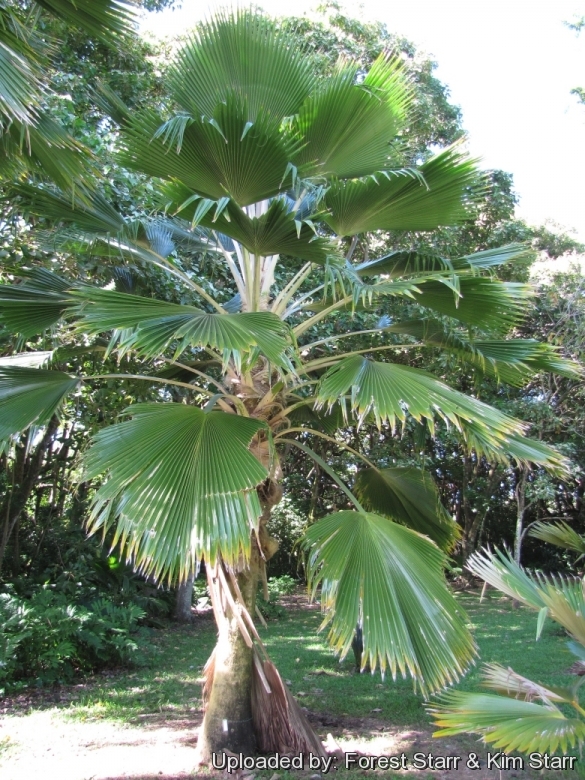
Washingtonia pacifica (Pritchardia pacifica) Photo by: Forest Starr & Kim Starr
Habit at Kahanu Gardens NTBG Kaeleku Hana, Maui, Hawaii (USA). November 04, 2009.
Origin and Habitat: Pritchardia pacificaSN|24641]]SN|24641]] is native to Tonga. It is also found on Fiji, Marquesas, Marshall Is., Niue, Samoa, Society Is., Solomon Is., Tonga, Trinidad-Tobago, Vanuatu however these populations are likely to be human introductions, sometimes escaping and growing wild in nearby secondary growth.
Altitude: 0-100 m elevation.
Habitat: Typically tropical dry forests with mean monthly temperatures ranging from 22°C in July to 28°C in January. Rainfall averages 1800 mm per year with most falling during December-April summer and almost drought conditions prevailing during the cooler months.
Synonyms:
See all synonyms of Pritchardia pacifica
back
Accepted name in llifle Database:Pritchardia pacifica Seem. & H.Wendl.Bonplandia 10: 197 (1862)Synonymy: 6
back
Common Names include:
ENGLISH: Fiji fan palm, Loulu
CHINESE (中文): Bo li cha de zong
GEORGIAN (ქართული): პრიტჩარდია
MALAY (بهاس ملاي /Bahasa Melayu ): Palma kipas Fiji
RUSSIAN (Русский): Притчардия
SPANISH (Español): Palma de Abanico
TONGAN (Faka-Tonga): Niupiu, Piu
Description: Pritchardia pacificaSN|24652]]SN|24641]] is one of the most attractive Pritchardia species with a smooth, attractive trunk and large, nearly round, barely split, flat fan leaves held in the crown. Commonly known as the Fiji fan palm after one of its uses, it can grow to a height of ten metres. It is grown widely in tropical countries and sought after by collectors.
Stem: Solitary 7-10(-15) m tall, up to 30 cm in diameter, grey brown, obscurely ringed with leaf scars, smooth or with irregular shallow vertical fissures.
Leaves: up to 1,8 m long and almost as wide, pleated at the base, and divided into 73 to 90 distinct sections in the upper half of the leaf, glabrous dull green slightly waxy-glaucous, on both upper and lower surfaces, without any scales or spots underneath, segment tips stiff. The leaves are held out from the stem by a long petioles (leaf stalk) with only a few fibres on the margins.
Inflorescence: One to four spadices (A fleshy spike enclosed within a sheath-like involucre characteristic of palms) are produced in each leaf axil (between the leaf stalk and the stem) and the inflorescence composed of 1-4 panicles springing out from the spathe is shorter than the leaf stalk. The panicles are branched to 2 orders, rachillae glabrous.
Flower: Three sepaled, around 7-8 mm long, yellow green colour. The flowers are bisexual, meaning they produce both pollen and ovules in a single flower.
Fruits: Spherical 11-12 mm in diameter, reddish-brown then black at maturity, containing a single seed.
Seeds: 7 mm in diameter.
Notes: It is often confused in cultivation with Pritchardia thurstoniiSN|24641]]SN|24652]] which is more irregular in shape with smaller leaves and much more inflorescences.
Bibliography: Major references and further lectures
1) Forest & Kim Starr Pritchardia pacifica (Fiji fan palm). Plants of Hawaii. <http://www.starrenvironmental.com>. Downloaded on 21 August 2014.
2) "Pritchardia pacifica." PACSOA Palms and Cycads wiki , <http://www.pacsoa.org.au> Accessed on 28 Aug. 2014
3) David Leaser "Growing Palm Trees in Hawaiʻi and Other Tropical Climates", page 78.
4) Heidi Leianuenue Bornhorst “Growing Native Hawaiian Plants: A How-to Guide for the Gardener” Bess Press, 01/Apr/2005
5) Palmpedia contributors. "Pritchardia pacifica." Palmpedia, PALM ENCYCLOPEDIA, <http://www.palmpedia.net> Downloaded on 26 Aug. 2014
6) Wikipedia contributors. "Pritchardia pacifica." Wikipedia, The Free Encyclopedia. Wikipedia, The Free Encyclopedia, 21 Jan. 2014. Web. 5 Sep. 2014.
7) Don Ellison, Anthony Ellison “Cultivated Palms of the World” UNSW Press, 2001
8) Sigmund Rehm “Multilingual Dictionary of Agronomic Plants” Springer Science & Business Media, 31/Jul/1994
9) Michael J. Balick, Hans T. Beck “Useful Palms of the World: A Synoptic Bibliography” Columbia University Press, 1990
10) Timothy Auger “Living in a Garden: The Greening of Singapore” Editions Didier Millet, 2013
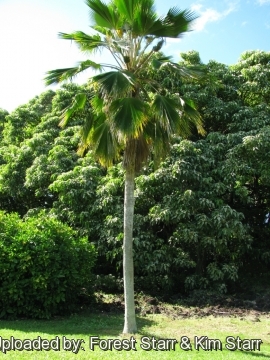 Habit at Kahanu Gardens NTBG Kaeleku Hana, Maui, Hawaii (USA). November 04, 2009. (Pritchardia pacifica) Photo by: Forest Starr & Kim Starr
Habit at Kahanu Gardens NTBG Kaeleku Hana, Maui, Hawaii (USA). November 04, 2009. (Pritchardia pacifica) Photo by: Forest Starr & Kim Starr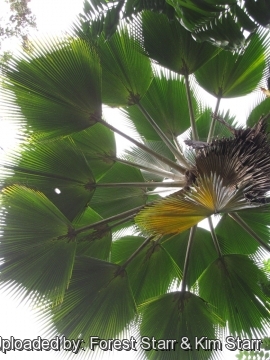 Canopy fronds at Keanae Arboretum, Maui, Hawaii (USA). February 16, 2012. (Pritchardia pacifica) Photo by: Forest Starr & Kim Starr
Canopy fronds at Keanae Arboretum, Maui, Hawaii (USA). February 16, 2012. (Pritchardia pacifica) Photo by: Forest Starr & Kim Starr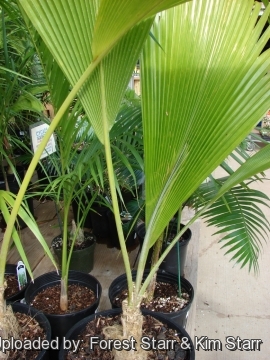 HABIT at Home Depot Nursery Kahului, Maui, Hawaii (USA). January 17, 2008. (Pritchardia pacifica) Photo by: Forest Starr & Kim Starr
HABIT at Home Depot Nursery Kahului, Maui, Hawaii (USA). January 17, 2008. (Pritchardia pacifica) Photo by: Forest Starr & Kim Starr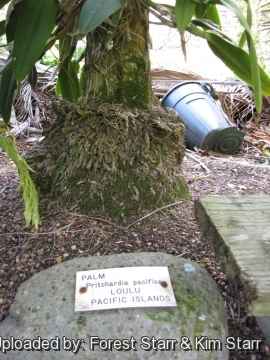 Habit and sign at Iao Tropical Gardens of Maui, Maui, Hawaii (USA). May 22, 2012. (Pritchardia pacifica) Photo by: Forest Starr & Kim Starr
Habit and sign at Iao Tropical Gardens of Maui, Maui, Hawaii (USA). May 22, 2012. (Pritchardia pacifica) Photo by: Forest Starr & Kim Starr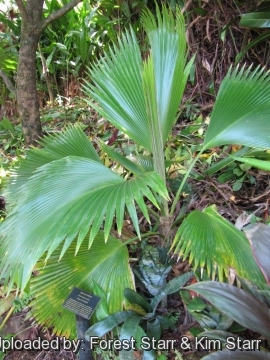 Habit at Garden of Eden Keanae, Maui, Hawaii (USA). March 30, 2011. (Pritchardia pacifica) Photo by: Forest Starr & Kim Starr
Habit at Garden of Eden Keanae, Maui, Hawaii (USA). March 30, 2011. (Pritchardia pacifica) Photo by: Forest Starr & Kim Starr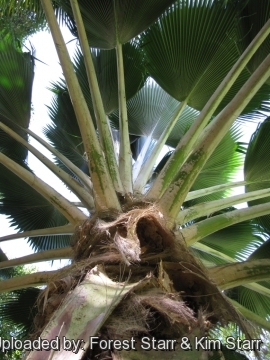 Crown at Kahanu Gardens NTBG Kaeleku Hana, Maui, Hawaii (USA). November 04, 2009. (Pritchardia pacifica) Photo by: Forest Starr & Kim Starr
Crown at Kahanu Gardens NTBG Kaeleku Hana, Maui, Hawaii (USA). November 04, 2009. (Pritchardia pacifica) Photo by: Forest Starr & Kim Starr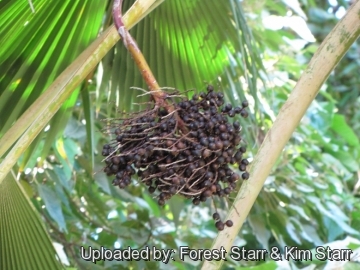 Fruit at Kahanu Gardens NTBG Kaeleku Hana, Maui, Hawaii (USA). November 04, 2009. (Pritchardia pacifica) Photo by: Forest Starr & Kim Starr
Fruit at Kahanu Gardens NTBG Kaeleku Hana, Maui, Hawaii (USA). November 04, 2009. (Pritchardia pacifica) Photo by: Forest Starr & Kim Starr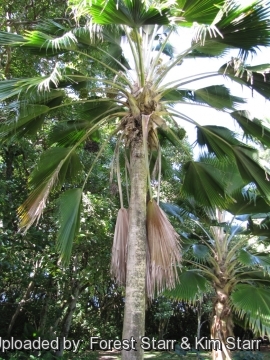 Habit at Kahanu Gardens NTBG Kaeleku Hana, Maui, Hawaii (USA). November 04, 2009. (Pritchardia pacifica) Photo by: Forest Starr & Kim Starr
Habit at Kahanu Gardens NTBG Kaeleku Hana, Maui, Hawaii (USA). November 04, 2009. (Pritchardia pacifica) Photo by: Forest Starr & Kim StarrCultivation and Propagation: According to its habitat Pritchardia pacificaSN|24641]]SN|24641]] may be salt tolerant, slow growing and modest in its requirement.
Soil: Sand, cinder, ororganic soil, but is adaptable. Good drainage is also important.
Fertilization: Need a perfect fertilizer diet including all micro nutrients and trace elements or slow release fertilizer. Fertilize often for faster growth.
Water Requirements: It tolerates low levels of humidity, though it prefers evenly moist but not consistently wet medium. When supplied with adequate moisture and fertilizer it is also fairly fast growing. This palm is moderately drought tolerant once established. It dislikes soggy soils. The roots and lower trunk can rot if soil is kept too moist. Water young plants for healthy look and fastest growth.
Light: Prefers full sun but will tolerate half day sun.
Hardiness: It is adapted to tropical and subtropical climates but tolerate a wide range of climates and will even tolerate cool conditions, but is marginal where winter temperatures go below 5°C. In favourable temperate climate they should be grown in cold green houses or at least in a place where they are sheltered by the wind; However mature specimens can endure light frost (for short periods), while young plants are more cold sensitive. Best kept above 5° C.
Wind and salt tolerance: This species is particularly tolerant of seaside conditions and salt spray, making it an excellent choice for planting along the coasts in the tropics. With a particularly windy climate it is suggested to secure young palm to long solid stakes, to avoid that the wind could bare young and not very developed roots; specimens which are only a few years old might fear intense wind, but as it becomes a tall palm it can look ratty after the winds.
Maintenance: The dead leaves, flowers and fruits can be removed in a landscape setting for a cleaner appearance. Do not prune the fronds that still have some green colour. Palms recycle nutrients from dead or dying fronds and use them for healthier fronds. Palms only have a set number of new leaves that can sprout and grow per year and removing fronds will not increase that number. If you cut off more than what will grow annually, you could be left with a pretty bare and bald palm. Left in place they form an attractive ‘skirt’ around the trunk.
Pest & disease: They are prone to lethal yellowing disease.
Ornamental: It is one of most cultivated ornamental palm, planted in gardens and parks in tropical and sub-tropical climates either as a single specimen in small groves of three or more palms. Culture in containers is possible although growth rates are slower. A bright patio will provide an excellent environment for young specimens which can eventually be planted in a sunny location.
Propagation: The fresh seed germinates well within 30 days buried half way in pot of clean, well drained potting soil in high light environments, water daily. Seedling grows moderately, plants of 30 cm can be put in ground/larger pot; Because these palms easily hybridize with other Pritchardias, claiming a specific species requires seed collection from wild populations.

















